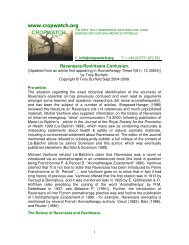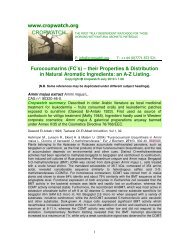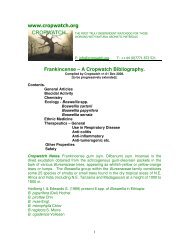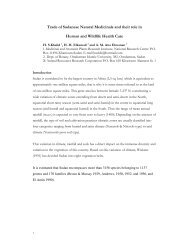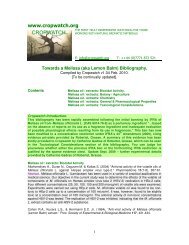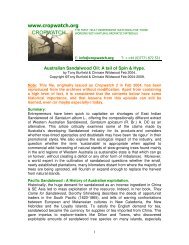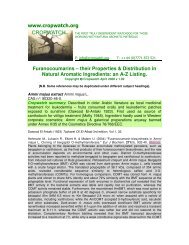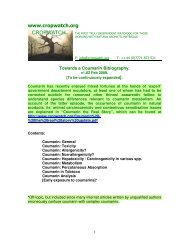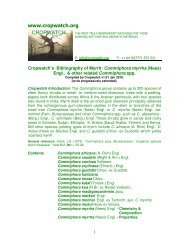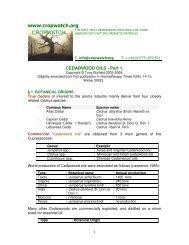Sandalwood Biblio - Cropwatch
Sandalwood Biblio - Cropwatch
Sandalwood Biblio - Cropwatch
You also want an ePaper? Increase the reach of your titles
YUMPU automatically turns print PDFs into web optimized ePapers that Google loves.
especially Acacia acuminata. This establishment technique has been very effective, with over 80<br />
% survival per spot, and mean stem diameters (at 150 mm above the ground) increasing at 10-12<br />
mm yr-1near A. acuminata. Allowing two years to establish both A. acuminata and S. spicatum,<br />
and then a mean stem diameter growth of only 7 mm yr-1for 18 years, the S. spicatum are<br />
expected to reach commercial size (127 mm) at plantation age 20 years. At this age, the<br />
expected yields are approximately 4.4 tonnes ha-1, with a net return ofover AU $14,000 ha-1.<br />
The sandalwood trees are also producing 60-170 kg ha- 1of seeds at age only 4-6 years. The<br />
value of the seeds may also provide a supple-mentary income to the sandalwood growers, while<br />
they are waiting for the trees to reach commercial size. <strong>Cropwatch</strong> comments: The authors<br />
state that core samples taken from 10-year old trees produced oil containing 16.7 to 21.1% α- &<br />
β-santalols, “which are the compounds that produce the distinct sandalwood fragrance”<br />
referencing Adams et al. (1975), The authors take no account of the effect on the odour profile of<br />
other major components found in the oil, such as the presence of 17.8% to 20.5% farnesol, a<br />
sesquiterpene alcohol recently identified as a sensitiser by IFRA and the subject of a recent<br />
SCCP Opinion.<br />
Braun N.A. & Meier M. (2004) “Western Australian & East Indian sandalwood oil – a comparison”<br />
Euro Cosmetics 12(1), 22-29.<br />
Bristow, M. et al. 2000. "Queensland sandalwood (Santalum lanceolatum): regeneration following<br />
harvesting." <strong>Sandalwood</strong> Research Newsletter 11, 4-8.<br />
Burfield T. & Wildwood C. (2004) “<strong>Cropwatch</strong> 2: Australian <strong>Sandalwood</strong> Oil: a tale of Spin &<br />
Hype” at http://www.cropwatch.org/cropwatch2.htm & www.users.globalnet.co.uk/~nodice/<br />
Byrne M., McDonald B. & Brand J. (2003) “Phylogeography & divergence in the chloroplast<br />
genome of Western Australian sandalwood (Santalum spicatum) Heredity 91(4), 389-395.<br />
Abstract. Western Australian sandalwood (Santalum spicatum) is widespread throughout Western<br />
Australia across the semiarid and arid regions. The diversity and phylogeographic patterns within<br />
the chloroplast genome of S. spicatum were investigated using restriction fragment length<br />
polymorphism analysis of 23 populations. The chloroplast diversity was structured into two main<br />
clades that were geographically separated, one centred in the southern (semiarid region) and the<br />
other in the northern (arid) region. Fragmentation due to climatic instability was identified as the<br />
most likely influence on the differentiation of the lineages. The lineage in the arid region showed a<br />
greater level of differentiation than that in the southern region, suggesting a higher level of gene<br />
flow or a more recent range expansion of sandalwood in the southern region. The<br />
phylogeographic pattern in the chloroplast genome is congruent with that detected in the nuclear<br />
genome, which identified different genetic influences between the regions and also suggested a<br />
more recent expansion of sandalwood in the southern region.<br />
Byrne M., McDonald B., Broadhurst L. & Brand J. (2003) “Regional genetic differentiation in<br />
Western Australian sandalwood (Santalum spicatum) as revealed by nuclear RFLP analysis.”<br />
Theoretical & Applied Genetics 107(7), 1208-1214. Abstract. Western Australian sandalwood,<br />
Santalum spicatum, is widespread in the semi-arid and arid regions of Western Australia, and<br />
there is some morphological variation suggestive of two ecotypes. The level and structuring of<br />
genetic diversity within the species was investigated using anonymous nuclear RFLP loci.<br />
Santalum spicatum showed moderate levels of genetic diversity compared to other Australian<br />
tree species. The northern populations in the arid region showed greater levels of diversity and<br />
less population differentiation than the southern populations in the semi-arid region due to<br />
differences in the distribution of rare alleles. Equilibrium between drift and gene flow in the<br />
northern populations indicated that they have been established for a long period of time with<br />
stable conditions conducive to gene flow. In contrast, the southern populations showed a<br />
relationship between drift and gene flow indicative of a pattern of fragmentation and isolation<br />
where drift has greater effect than gene flow. The different patterns of diversity suggest that the<br />
ecotypes in the two regions have been subject to differences in the relative influences of drift and<br />
gene flow during their evolutionary history.<br />
10





